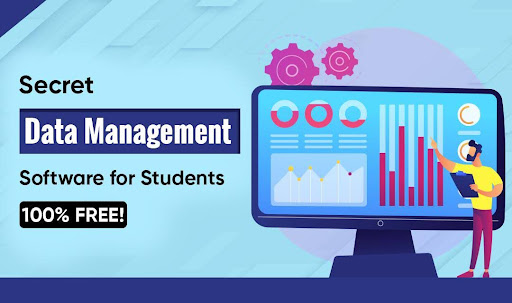Managing data can be a challenging task for students, as they often struggle with raw data processing, categorisation, and maintaining accuracy. However, digital database systems simplify this process by offering tools that efficiently organise, store, and manage large volumes of data.
Database software operates on a large scale, handling complex data from multiple interconnected systems. A survey by Security Magazine reveals that approximately 93% of organizations rely on data management software for storing and monitoring their information. Students, too, can benefit from such tools to streamline their research and save valuable time.
However, with countless options available online, finding the right data management software can be difficult. To help with this, we have compiled a list of the best free data management software for students.
Let’s dive in!
What Is an Example of a Data Management System?
Relational Database Management System (RDBMS) is a common system for data management which lets users manage and store the data in a structured and organised manner in tables having predefined relationships. According to Enterprise Storage Forum, these data management systems are suitable for applications like e-commerce and finance.
Some most common examples of a data management system are the following:
-
- Microsoft SQL Server
- NoSQL Databases
- Data Quality Portals
- Azure Data Factory
- MS SQL Server
- Management Information System

04 Best 100% Free Data Management Software for Students
When choosing data management software, there’s no universal “best” option. It all depends on your academic or business needs. Some tools stand out due to their ease of use and beginner-friendly features, making them more popular among students.
For those studying data management, mastering complex tools can be challenging, especially when writing research papers or dissertations. Lack of experience with advanced software often makes academic writing more difficult. In such cases, students can seek assistance from a custom dissertation writing service, where professional researchers help them complete their work on time.
For students looking for completely free data management software, the best options are listed below.
1. Couchbase
This is one of the feature-rich database management systems that small and midsize organisations use for the management of their large-sized data. The most common industries using Couchbase include hotels, energy, information technology, retail, telecommunications and manufacturing industries. Students can use it free and follow a document-oriented distributed database that involves the combination of 2 popular NoSQL technologies: CouchDB and Membase.
Top Features
-
- Couchbase acts as the best and most flexible data model.
- The architecture of this tool ensures fault tolerance in the data management software systems.
- It also ensures the provision of NoSQL capabilities
- There may be high memory usage from this tool and the configuration may be a bit complex
2. Amazon Relational Database Service
Known as RDS, this data management software enables students to manage, build and expand different databases in the cloud storage options. It automates many time-consuming administrative tasks and offers scalable capacity to the users. The entire setup includes the backups, setups, patch-ups and hardware provisioning. Several businesses can focus on the services they provide by using this software program and provide them with needed security and performance.
Top Features
-
- Amazon RDS data management software supports a wide range of database engines.
- There are several automated backups available to the users
- The strong indexing is also present that students can benefit from
- You can also use this tool to manage content gathered from effective ways of data collection for research
3. IBM Db2
This is one of the RDBMS data management software that can efficiently store, analyse and retrieve different kinds of data. Companies of all sizes and stature prefer using IBM D2 because it provides complete tracking for analytical and transactional processes. When learning about it, students can see the continuous availability of data necessary for running the data smoothly. The best thing about IBM Db2 is that it can support JSON, graph store XML and several other NoSQL features.
Top Features
-
- If the users are struggling with demanding workloads, they can use IBM Db2.
- It is available on all the cloud platforms.
- You can use this data management software in growing organisations because it supports advanced analytical capabilities.
4. ArangoDB
This data management software is highly scalable and acts as a multi-model database that excels in handling interconnected and complex data structures. As it follows a document database, students can use it for optimisation and storage of data in JSON format. The applications that are used for quick data management and efficient development use this software.
Top Features
-
- It is excellent for retrieving data from multiple sources and collections
- It is also used as a multi-modelling database
- ArangoDB can be used for learning the intuitive query language for this software.
Which Course Is Best for Data Management?
The career goals and skill level of a person determine what data management course will suit them the best. Generally, a good course on data management should have the following properties:
-
- It should cover all the foundational concepts of database management.
- It should also enable students to practically use an application and provide them with an understanding of programming languages like Python.
- If you are a beginner, you should go for the introductory courses that cover the basic data management principles for students.
- If you want to focus on data governance and data warehousing, you should choose a course that aligns with your desired specialisation.
Some highly recommended data management courses, that students can pursue to learn data management at a basic or specialised level, are listed here:
-
- IBM Data Engineering at Coursera
- Data Architecture at edX
- AWS Cloud Solutions Architect by AWS
- Database Structures and Management with MySQL by Coursera
What Are the Four Types of Data Management?
Instead of letting individual individuals or departments handle the information manually, data management software should be used by the companies. For all kinds of data, management software can organise the workflow and the gathered data. As per the Adobe Experience Cloud, there are 4 main types of data management which are shared here:
1. Data Pipelines
A business can automatically transfer information between two or more systems using robust data pipelines. IBM defines the data pipeline as a method where a data lake stores, ingests, transforms and keeps the raw data. For instance, a business may connect its internal sales software to the main website so that the lead profiles may be bulked up. Sometimes, a pipeline enhances the given data but it can also leave it as it is.
2. Data Architecture
As we all know, architecture gives rise to the data strategies of all kinds. Using this data management style, students can build out the information flow throughout a system. Students usually take it as a formal process to manage the research data following a basic and strong framework. From the storage to the end consumption by users, data architecture almost covers everything.
3. ETLs
You can call it a type of data pipeline that can extract data from a given database and transform it using formatting guidelines. This can be placed in a new location for storage and the benefit of using an ETL is that it receives data from multiple channels and provides single and dedicated solutions.
4. Data Modelling
The data models show a visual depiction of how data can flow smoothly in a given system. These modelling diagrams can help people see the flow of data in single or interconnected systems. Several businesses create different data models to meet varying aims in an organisational setting.
What Application Software Is Used to Manage Data Like Budgets?
The most commonly used application software to manage data like budgets, as per Smithing Systems, includes MS Excel, Apple Numbers and Google Sheets. People may also use dedicated budgeting software such as QuickBooks, YNAB, Xero and more. Depending on the complexity of the needs of students and business size, any particular application software can be picked.
Is Excel Data Management Software?
According to Microsoft Support, students can use Excel to connect to a large variety of data sources such as SQL Server, Access, and other Analysis Services databases. Otherwise, Excel is not considered a dedicated data management software. It is just a specialised spreadsheet application that can analyse data in the form of a structured table format.
However, for the management of complex data on a large scale, students must use dedicated data management software. Using Excel, students can only perform basic data arithmetic and manipulate the given data to get the needed results.
Conclusion
We have discussed the details of the best data management software for students that is free to use. Students need to have a basic understanding of how these tools work and they will be able to manage their complex research data in a few clicks.
However, it is a complicated process that often confuses students and impedes their progress. To solve this issue, they often get support from British dissertation writing firms that give model research assistance to students. Since these platforms are home to professional writers, you can get your work done in less than no time.
The importance of effective and efficient data management during the dissertation research work cannot be emphasised enough. Using the software we discussed in this article, students can ensure that their data is safe and organised for proper usage.







